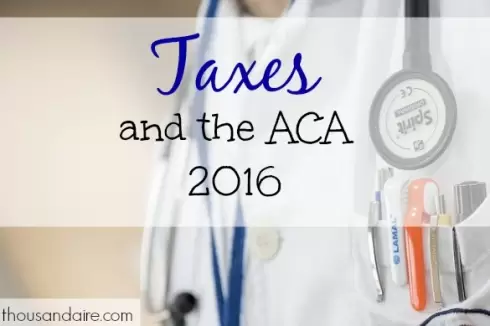
If you get health insurance through your work, great, you’re pretty much done. You need not read this article. For those of you who need to buy health insurance through an Obamacare health insurance marketplace, read on.
Tax Credits
First thing that you need to keep in mind is that the premiums that you see on a website like: connectforhealthcolorado.com are not the actual premiums you will be paying. There are significant tax credits which subsidize the cost of the health insurance for you. While it may appear that your health insurance coverage will cost $400 or $500 per month the real cost might be substantially lower, say, $150 to $200 per month. If you make less than 400% of the federal poverty guideline then you could be eligible for a tax credit to help pay for premiums on a monthly basis. What is the federal poverty guideline?
- $11,880 for individuals ($47,520)
- $16,020 for a family of 2 ($64,080)
- $20,160 for a family of 3 ($80,640)
- $24,300 for a family of 4 ($97,200)
- $28,440 for a family of 5 ($113,760)
So if you’re an individual that makes less than $47,520 you may be able to get a tax credit for some of the health care premium you have to pay. How much? Well, it depends. The tax credit is the difference between the amount the government thinks you can afford to spend on healthcare and the cost of the second cheapest silver health insurance plan available. So, if the government thinks you can afford $400 per month, and the second cheapest silver plan is $500 per month, then you get a tax credit of $100 per month. This caps out at the amount you actually spend on premiums. You can’t then buy a bronze plan that costs $50 per month and pocket the extra $50.
How much does the government think you can afford to spend on health insurance? Well, if you’re poor, it’s figured to be about 2%, that value scales continuously up to about 9.5% once you hit 300% of the federal poverty level. So, the maximum annual income for an individual to qualify is $47,520. 9.5% of that is about $4,500. That means, on a monthly basis you’re expected to shell out $376 for health insurance premiums. In my state the second cheapest silver plan is cheaper than that for 20 somethings. This means I would receive no tax credit even though I’m at 400% of the poverty level.
MAGI magic
The best and craziest news about this is that all of this is based on your MAGI, or your modified adjusted gross income. In a taxation sense you don’t have much control over your gross income, and you pretty much always want it to be higher, it is very rare in our tax code for an additional dollar of income not to be worth additional money. Your MAGI however, you have some control over, and since you have some control you can optimize it. The main difference for ACA purposes is that the MAGI doesn’t include retirement contributions. This is where the craziness begins. If you’re self employed you can contribute up to 25% of your salary towards a SEP-IRA as the employer end of the contribution. On the employee end you can then go ahead and contribute the regular $5,500 to a traditional IRA, and also $3,000 for a Health Savings Account (HSA). This means that if you made $47,520 your MAGI could be as low as $29,516. Using our Colorado example again that’d bring us from an annual credit of $0 to an annual credit of $360. If I were instead 45 that annual credit would be $1,404! This means that the older you are (and the higher your health insurance premiums are), the more value you’re going to see out of making retirement contributions as far as the ACA goes.
Bronze, Silver, why is my healthcare metallic?
My only assumption is that the author of the ACA must have been a huge D&D fan and wanted to name the different tiers of health insurance after Dragons.

The healthcare tiers are Bronze, Silver, Gold, and Platinum. These tiers correspond to different amounts of “actuarial value”. The actuarial value of a plan is the expected contribution of the health plan towards healthcare costs compared to the total healthcare cost. For example, let suppose that the average person in a particular health care plan incurs $100 of doctor/hospital bills. If the actuarial value of the plan is 60% that means that the insurer is, on average, covering $60 and the customer is, on average, covering $40. This is supposed to give customers a quick way of comparing two different plans. The theory is that two silver plans should be comparable and two gold plans should be comparable. The actuarial value of the different tiers are: Bronze – 60%, Silver – 70%, Gold – 80%, and Platinum – 90%. My generic advice is that folks that are generally healthy should aim for cheaper, on average, plans. If you have a big health expense coming up, shell out for a more expensive plan (better yet carefully calculate these costs in advance). You should note, that because the tax credit is based on a silver plan there is a relative advantage to getting a cheaper plan. The government is just giving you a flat dollar value of tax credit. If you’re getting $100 per month you might find that this pays for 50% of your bronze plan, but only 10% of a platinum plan. In order to determine what sort of health plan is right for you, you might consider checking out our article on High Deductible Health Plans.
Adam Woods is a physicist. His research interests include building software to run and build geomagnetic models. Adam got interested in personal finance in the great recession when it became obvious an interest was necessary.
After harassing his friends and family (and a short intervention) he took to the web where he blogs about finance, investment, politics, and economics.
Adam is currently located in Boulder, Colorado where he can generally be found hiking, biking, or running a D&D campaign. He can also be contacted at adamwoods137@gmail.com.

